![]()
![]()
![]()
Use LEFT and RIGHT arrow keys to navigate between flashcards;
Use UP and DOWN arrow keys to flip the card;
H to show hint;
A reads text to speech;
184 Cards in this Set
- Front
- Back
- 3rd side (hint)
|
Anatomical position |
Body standing, facing observer, arms near sides with palms facing observer |
|
|
|
Dorsal (posterior) cavity |
Cranial cavity - holds the brain Vertebral cavity - holds spinal cord |
|
|
|
Ventral (anterior) cavity |
1. Thoracic cavity A. Pleural cavity - lungs B. Mediastinum i. Pericardial cavity |
|
|
|
Abdominopelvic cavity |
- peritoneal cavity and membranes A. Abdominal cavity - liver stomach B. Pelvic cavity - urinary bladder |
|
|
|
Oral cavity |
Mouth |
|
|
|
Nasal cavity |
Nose |
|
|
|
Orbital cavity |
Eyes |
|
|
|
Serous membrane (serosa) |
Parietal serosa - superficial to visceral Visceral serosa - closest to organ |
|
|
|
Superior |
Above, closer to head |
|
|
|
Inferior |
Below, closer to feet |
|
|
|
Anterior (ventral) |
In front of Closer to front |
|
|
|
Posterior (dorsal) |
Behind |
|
|
|
Medial |
Closer to midline |
|
|
|
Lateral |
Further away from midline |
|
|
|
Proximal |
Closer to point of attachment to trunk |
|
|
|
Distal |
Further from point of attachment to trunk |
|
|
|
Superficial |
Closer to surface |
|
|
|
Deep |
Further from surface |
|
|
|
Intermediate |
Between 2 reference points |
|
|
|
Sagittal plane |
Divide into left and right |
|
|
|
Midsagittal |
Down midline |
|
|
|
Parasagittal |
Any cut not in the middle (down midline) that divides into left and right |
|
|
|
Transverse (cross section) |
Divided into superior and inferior (top and bottom) |
|
|
|
Frontal (coronal) *body planes* |
Divides into anterior and posterior (front and back) |
|
|
|
Oblique (Body planes) |
Any diagonal cut |
|
|
|
Abdominal region |
Same as abdominal cavity (stomach) |
|
|
|
Acromial region |
Point of shoulder |
|
|
|
Antebrachial region |
Forearm |
|
|
|
Antecubital region |
Front of elbow (IV spot) |
|
|
|
Axillary region |
Armpit |
|
|
|
Brachial region |
Upper arm (bicep) |
|
|
|
Buccal region |
Cheek |
|
|
|
Calcaneal region |
Heel of foot |
|
|
|
Carpal region |
Wrist |
|
|
|
Cephalic region |
Head |
|
|
|
Cervical region |
Neck |
|
|
|
Coxal region |
Hip |
|
|
|
Crural region |
Shins |
|
|
|
Digital region |
Fingers |
|
|
|
Epigastric region |
Upper stomach |
|
|
|
Femoral region |
Thighs |
|
|
|
Fibular region |
Side of leg (fibula side) |
|
|
|
Frontal region |
Forehead |
|
|
|
Gluteal region |
Butt |
|
|
|
Hallux region |
Big toe |
|
|
|
Hypogastric region |
Lower stomach |
|
|
|
Inguinal region |
Groin |
|
|
|
Left/right hypochondriac region |
Left/right upper ribs |
|
|
|
Left/right iliac (inguinal) region |
Left/right lower ribs |
|
|
|
Left/right lumbar region |
Left/right middle ribs |
|
|
|
Lumbar region |
Lower back |
|
|
|
Mammary region |
Breast |
|
|
|
Manus region |
Hand |
|
|
|
Mental region |
Chin |
|
|
|
Nasal region |
Nose |
|
|
|
Occipital region |
Lower back of head |
|
|
|
Olecranal region |
Back of the elbow |
|
|
|
Oral region |
Mouth |
|
|
|
Orbital region |
Eyes |
|
|
|
Otic region |
Ear |
|
|
|
Palmar region |
Palm |
|
|
|
Patellar region |
Front of knee (patella) |
|
|
|
Pedal region |
Whole foot |
|
|
|
Pelvic region |
Pelvis |
|
|
|
Perineal region |
Between anus and genitals |
|
|
|
Plantar region |
Bottom of foot |
|
|
|
Pollex region |
Thumb |
|
|
|
Popliteal region |
Back of knee |
|
|
|
Pubic region |
Genital region |
|
|
|
Sacral region |
Above butt (tailbone) |
|
|
|
Scapular region |
Shoulder blade |
|
|
|
Sternal region |
Sternum |
|
|
|
Sural region |
Calf |
|
|
|
Tarsal region |
Ankle |
|
|
|
Thoracic region |
Chest |
|
|
|
Umbilical region |
Belly |
|
|
|
Vertebral region |
Spinal column |
|
|

1 2 3 4 5 6 7 8 9 10 11 |
1. Eyepiece 2. Interpupillar distance scale 3. Main light switch 4. Light intensity knob 5. Slide holder 6. Fine focus knob 7. Coarse focus knob 8. Stage movement knobs 9. Iris diaphragm knob 10. Stage 11. Objective lenses |
|
|
|
Nucleolus |
Makes ribosomes |
|
|
|
Chromatin |
Codes for proteins |
|
|
|
Cytosol |
Suspense |
|
|
|
Rough endoplasmic reticulum |
Role in protein synthesis |
|
|
|
Smooth endoplasmic reticulum |
Lipid metabolism |
|
|
|
Ribosome |
Make proteins |
|
|
|
Golgi apparatus |
Packs and ships |
|
|
|
Mitochondria |
Makes ATP |
|
|
|
Vesicles |
Transport |
|
|
|
Centrosome |
Cellular reproduction |
|
|
|
Centrioles |
Organizes chromosomes |
|
|
|
Peroxisomes |
Detoxifies |
|
|
|
What are the four major categories of tissue? |
Epithelia Connective Muscular Nervous |
|
|
|
Cell membrane (plasma membrane) |
Protects cell |
|
|
|
Nucleus |
Holds DNA |
|
|
|
Nuclear envelope |
Protects nucleus |
|
|
|
Golgi apparatus |
Packs and ships |
|
|
|
Lysosomes |
Digest |
|
|

Identify slide and function |
Simple squamous epithelium Moving stuff from one side to the other |
|
|
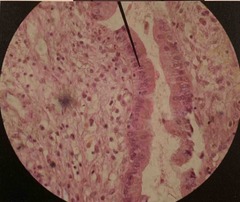
Identify slide and function |
Simple columnar epithelium Secretes mucus (goblet cells with columnar) |
|
|

Identify slide and function |
Simple cuboidal epithelium (ANYTHING SIMPLE) moving stuff from one side to the other |
|
|
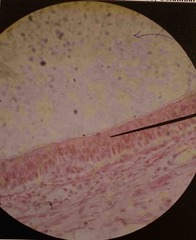
Identify slide and function |
Pseudostratified (ciliated) columnar epithelium Moving substances across top using cilia |
|
|
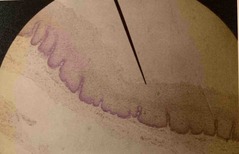
Identify slide and function |
Stratified squamous epithelium Protection |
|
|
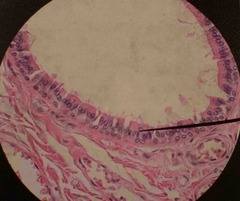
Identify slide and function |
Stratified columnar epithelium Protection |
|
|

Identify slide and function |
Transitional epithelium Stretch |
|
|
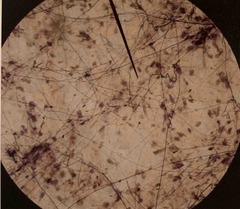
Identify slide and function |
Areolar connective tissue Support |
|
|
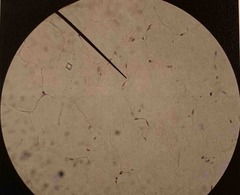
Identify slide and function |
Adipose tissue Energy storage, insulation |
|
|
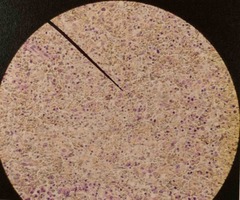
Identify slide and function |
Reticular connective tissue Supports |
|
|

Identify slide and function |
Regular connective tissue Support |
DENSE |
|
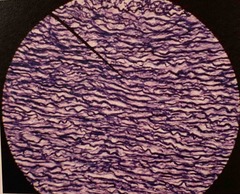
Identify slide and function |
Elastic connective tissue Support |
|
|

Identify slide and function |
Hyaline cartilage Support |
|
|
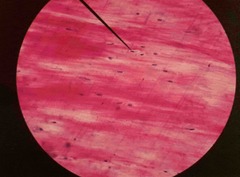
Identify slide and function |
Fibrocartilage Support |
|
|
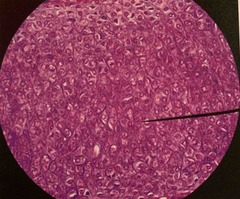
Identify slide and function |
Elastic cartilage Support |
|
|

Identify slide and function |
Osseous (bone) tissue Supoort |
|
|
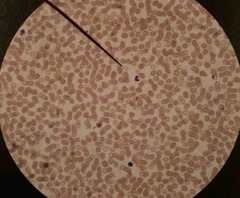
Identify slide and function |
Blood Transport |
|
|
|
What are the layers of the epidermis going from superficial to deep? |
Stratum corneum Stratum lucidum (only in thick skin) Stratum granulosum Stratum spinosum Stratum basale |
Candy Looks Good So Bad |
|
|
What is the function of a melanocyte? |
Protection |
|
|
|
Where is thick skin found on the body? Where is thin skin found on the body? |
Hands and soles of feet Everywhere else |
|
|
|
What are the layers of the dermis? |
Papillary layer Reticular layer |
|
|
|
Function of a hair follicle? |
Supports/grows hair |
|
|
|
Function of a sebaceous gland? |
Oil gland, puts out sebum/oil for protection |
|
|
|
Function of a sweat gland? |
Cool down, decrease body temperature (thermoregulation) |
|
|
|
Function of the arrector pili muscle? |
Increase body temperature |
|
|
|
What is the name and function of the layer that lies deep to the dermis? |
Hypodermis (subcutaneous layer) Connects |
|
|
|
Diaphysis *Structures of the long bone* |
Elongated shaft |
|
|
|
Epiphysis *Structures of the long bone* |
Ends of long bones |
|
|
|
Epiphyseal line (plate) *Structures of the long bone* |
Plate of hyaline cartilage between epiphysis and diaphysis |
|
|
|
Medullary cavity *Structures of the long bone* |
Center of long bones |
|
|
|
Location of yellow marrow? |
In medullary cavity |
|
|
|
Location of red marrow? |
In spongy bone (All blood cells made here) |
|
|
|
Location of periosteum? |
Connective tissue membrane surrounding each living bone |
|
|
|
Location of articular cartilage? |
Epiphysis |
|
|
|
Compact bone |
Hard outer smooth bone |
|
|
|
Spongy bone |
Inner bone made of flat pieces |
|
|
|
Nutrient foramen *Structures of the long bone* |
Hole in the wall of diaphysis for arteries and veins |
|
|
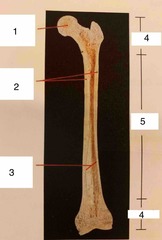
Label parts of bones |
1. Spongy bone 2. Compact bone 3. Medullary (marrow) cavity 4. Epiphysis (head) 5. Diaphysis (shaft)
|
|
|
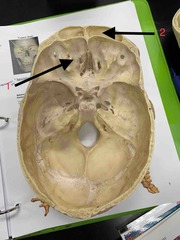
1 2 |
1. Frontal bone 2. Frontal sinus |
|
|
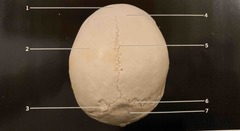
(View of skull from above) 2 4 5 |
2. Parietal bone 4. Coronal suture 5. Sagittal suture |
|
|
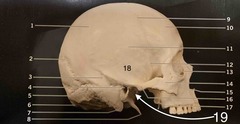
18 11 19 4 16 |
18. Temporal bone 11. Squamosal suture 19. Mandibular fossa 4. External auditory (acoustic) meatus 16. Zygomatic process |
|
|
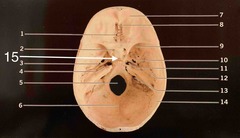
9 2 15 |
9. Sphenoid bone 2. Optic foramen (canal) 15. *Sella turcica *thing that makes a “u” type shape |
|
|
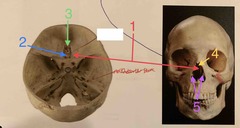
1 (upper half of nasal septum and posterior to it) 2 3 4 5 |
1. Ethmoid bone 2. Cribriform plate 3. Crista galli 4. Perpendicular plate 5. Nasal concha |
|
|

11 1 2 |
11. Mandible 1. Mandibular condyle 2. Mandibular foramen |
|
|
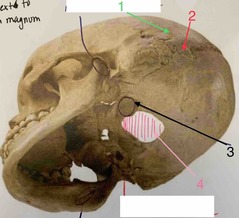
1 2 3 4 |
1. Occipital bone 2. Lambdoidal suture 3. Occipital condyle 4. Foramen magnum |
|
|
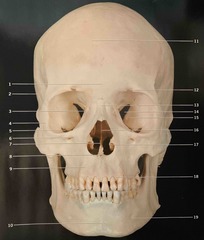
9 |
9. Maxillary bone (maxilla) |
|
|
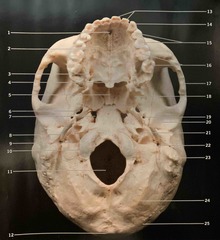
4 |
4. Palatine bone |
|
|
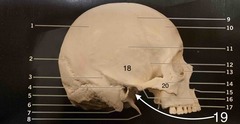
20 14 |
20. Zygomatic bone 14. Temporal process |
|
|
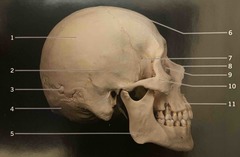
9 |
9. Lacrimal bone |
|
|
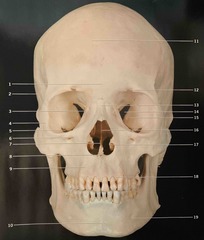
13 |
13. Nasal bone |
|
|
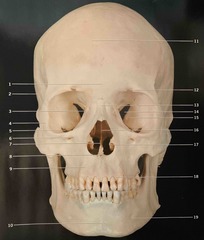
7 |
7. Vomer bone |
|
|

(Structures of the fetal skull) 1 2 3 |
1. Anterior fontanel 2. Posterior fontanel 3. Frontal suture |
|
|

(Vertebra) Label structures |
1. Body 2. Vertebral foramen 3. Spinous process 4. Transverse process 5. Lamina 6. Articulating process 7. Intervertebral foramen 8. Intervertebral disc |
|
|
|
What is the difference between the atlas bone (C1) and the axis bone (C2)? |
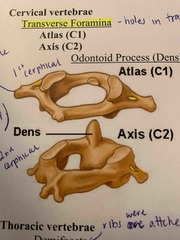
Atlas does not have a body Axis has the Dens (odontoid process) and a body |
Cervical vertebrae |
|
|
What is the difference between the cervical vertebrae, thoracic vertebrae, and lumbar vertebrae? |
Cervical- body with transverse foramina (holes in transverse processes) Thoracic- demifacets (ribs were attached there, kind of rough, posterior lateral side) Lumbar- no demifacets, smooth |

#8 (fig. 3.32) shows transverse foramen which is only on cervical #6 (fig. 3.35) shows the demifacet this will not be on lumbar or cervical vertebrae |
|
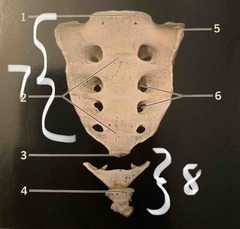
7 8 |
7. Sacrum 8. Coccyx |
|
|
|
True ribs |
First seven (superior to anterior) own piece of costal cartilage attached to sternum |
|
|
|
False ribs |
Last three ribs, share costal cartilage to attach to sternum |
|
|
|
Floating ribs |
Don’t connect the sternum |
|
|
|
Costal cartilage |
Cartilage of the ribs |
Costal = ribs |
|
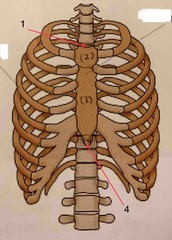
A. Bone? 1 2 3 4 |
A. Sternum 1. Jugular notch 2. Manubrium 3. Body 4. Xiphoid process |
|
|

What bone? |
Clavicle |
|
|
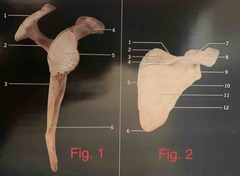
A. Bone? (Fig. 1/Fig. 2) 5/9 4/7 1/8 2/4 |
A. Scapula 5/9. Glenoid cavity 4/7. Coracoid process 1/8. Acromion process 2/4. Spine |
|
|
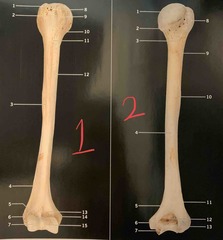
A. Bone? (Fig. 1/Fig. 2) -/1 1/8 9/- 13/- -/12 7/- 15/7
|
A. Humerus -/1. Head 1/8. Greater tubercle 9/-. Lesser tubercle 13/-. Coronoid fossa -/12. Olecranon fossa 7/-. Capitulum 15/7. Troclea |
|
|

A. Bone? (Left/right) 1/1 5/2 |
A. Radius 1/1. Head 5/2. Radial tuberosity |
|
|
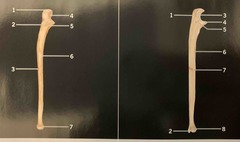
A. Bone? (L/R) 1/1 4/3 5/4 |
A. Ulna 1/1. Olecranon process 4/3. Trochlear notch 5/4. Coronoid process |
|
|
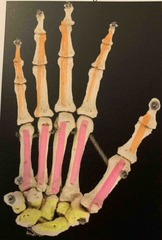
Orange Pink Yellow |
Orange- phalanges Pink- metacarpal bones Yellow- carpal bones |
|
|

A. Bone? (L/R) NA- name of space where coccyx is? 1/- 7/- 18/- 15/- 11/1 5/14 4/13 9/8 |
A. Coxal bone 1/-. Ilium 7/-. Ischium 18/-. Pubis 15/-. Acetabulum 11/1. Iliac crest 5/14. Ischial spine 4/13. Greater sciatic notch 9/8. Obturator foramen |
|
|
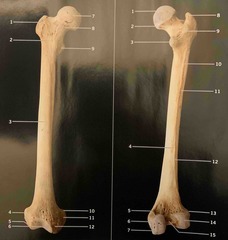
A. Bone (L/R) 7/1 8/2 1/8 9/3 5/14 12/7 -/11 |
A. Femur 7/1. Head 8/2. Neck 1/8. Greater trochanter 9/3. Lesser trochanter 5/14. Lateral condyle 12/7. Medial condyle -/11. Linea aspera |
|
|
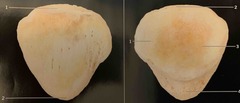
Bone? |
Patella |
|
|
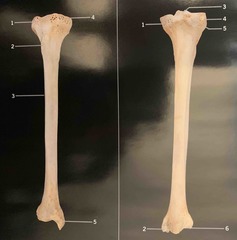
A. Bone (L/R) 1/4 4/1 5/2 |
A. Tibia 1/4. Lateral condyle 4/1. Medial condyle 5/2. Medial malleolus |
|
|
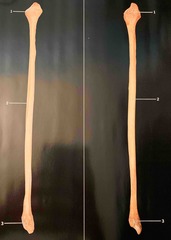
Bone? |
Fibula |
Has one flat side |
|

1 8 Yellow Pink Orange |
1. Calcaneus 8. Talus Yellow- tarsal bones Pink- metatarsal bones Orange- phalanges |
|
|
|
Condyle |
Rounded projection |
|
|
|
Crest |
Narrow ridge |
|
|
|
Epicondyle |
Raised area on or above a condyle |
|
|
|
Fissure |
Narrow slit like opening |
|
|
|
Foramen |
Round or oval hole |
|
|
|
Fossa |
Shallow depression |
|
|
|
Line |
Narrow ridge smaller than crest |
|
|
|
Meatus |
Canal like passage |
|
|
|
Notch |
Indentation |
|
|
|
Process |
Bony prominence (sticks out) |
|
|
|
Sinus |
Air filled cavity |
|
|
|
Spine |
Sharp pointed projection |
|
|
|
Trochanter |
Very large blunt irregular shaped process of femur |
|
|
|
Tubercle |
Small rounded projection |
|
|
|
Tuberosity |
Large rounded projection |
|

